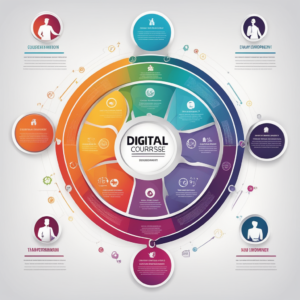Introduction:
In the digital age, a good website is crucial. People and groups need to make their mark online. This thorough guide will provide step-by-step instructions on designing a competitive website in the market despite your experience as a web designer. We will cover all the necessary steps. They go from planning and research to implementation and launch. This will help you create an appealing website.
Chapter 1: Understanding the Importance of Website Design
1.1 The Role of Website Design in the Online Landscape:
Website design is like the appearance and organization of a website. It’s important because it affects how people see and use a website. An excellent website design that is easy to use helps businesses. It makes them seem trustworthy and gives users a good experience.
1.2 Key Elements of Effective Website Design:
Good website design has easy-to-use buttons and menus. It has clear and organized information. It also has engaging visuals. These elements contribute to an appealing website.
1.3 Benefits of a Well-Designed Website:
A very much-planned site has many beneficial things about it. First, it gives guests a decent impression when they see it. It looks pretty coordinated. Second, it’s simple for individuals to use and find what they need. They can circumvent the site with no issues. Third, it makes the site’s owner seem reliable and skilled. A well-planned site can attract more visitors. This can help the company or person find real success.
In rundown, website design is significant because it influences how individuals see and use a site. Good website design has easy-to-use parts and looks nice. A good website has many good things. It makes a good impression, is easy to use, seems trustworthy, and brings more visitors.
Chapter 2: Planning and Research
2.1 Characterizing Your Website’s Motivation and Objectives:
When you make a website design, you need to know why you’re making it and what you need to do with it. The intention resembles the explanation or aim behind the site. For instance, you should share data about your side interests or sell items. Knowing the reason and goals helps. It ensures that your site engages and does what you say it should.
2.2 Conducting Market Research:
Market research is like investigating. It is about learning about the people who might visit your website. Understand what your listeners prefer. Also, understand their identity. Thorough research can help you find similar websites. It can also show why people like them. It informs you of the needs of your audience and what you can do to better your website Design.
2.3 Identifying Your Target Audience:
Your target audience is like the people you want to visit your website. Finding out who these people are is vital to make your website purposeful and appealing. For example, if you have a site for children and teenagers who are video gamers. By understanding your audience, you will make the right content and website design for them.
2.4 Gathering Content and Visual Assets:
Content and visual assets are like what you put on your website to make it interesting and informative. Content can be text, pictures, and videos. They help explain or show things. Visual assets are nice pictures or graphics that make your website look good. Gathering these things is vital. They must fit your website’s purpose and audience. You can create your content or find things online that you can use.
Finally, when developing your site, it pays to know why you are making it and what success means for it. You need to understand the people who may access your web pages. You need to understand their preferences. You know what resonates with your audience by analyzing their behaviour on social media. You then make sites that are interesting and useful to them. Finally, gather content and images that fit your site’s purpose. They should make it look good.
Chapter 3: Choosing the Right Platform
3.1 Evaluating Different Website Building Platforms:
Website-building platforms are like tools. They help you create and design your website. It would be best to consider that many platforms exist today and should be analyzed to choose the most suitable one. Consider it as selecting a paintbrush to help you create a masterpiece. So, what do these platforms have and do? Thus, we compare to see which platform works best. It relies on what people need.
3.2 Exploring Popular Website Builders:
Popular website builders are the most used tools to make websites. People use notable website builders like WordPress, Wix. and Squarespace. Each of these developers has distinct characteristics. Things it can do. It’s like exploring different toys and seeing what each one can do. This will help you know if they contain all you need from the other famous builders on your site.
3.3 Selecting the Best Platform for Your Needs:
In this respect, you must also consider what your site should achieve for you. Choosing the better one is selecting the game that fits your style and taste. Consider whether the application has essential features. Also, consider if it helps one advance toward their goals. Consider such things and choose a platform appropriate for your desire to build a site.
To sum up, web-building platforms are tools you use to construct your site. Look at offers from popular builders. Compare them to each other. Choose the one you prefer. It’s like picking a hammer, screwdriver, or another tool for a website job.
Chapter 4: Step-by-Step Guide to Designing Your Website
4.1 Creating a Site Map and Wireframe:
Planning how it will look and what pages it will have is essential when making a website. A site map is like a map that shows all the pages of your website and how they connect. It’s like making a plan before building a house. A wireframe is like a simple sketch or blueprint that shows where things will go on each page. It helps you decide where to put pictures, text, and buttons.
4.2 Selecting the Right Template or Theme:
A template or theme is like a pre-made design for your website. It’s like choosing a colouring book page to colour. Various templates or themes are available, each with its own appearance and style. Select the best-suited and preferred one for a website that aligns with the purpose.
4.3 Customizing the Design Elements:
Customizing means making changes. You can also add special touches to your chosen template or theme. It’s like adding your decorations to a cake. You can change the colours, fonts, and pictures. This will make your site unique and match your style or brand.
4.4 Creating Engaging and User-Friendly Navigation:
Navigation is like a website’s menu or buttons. They help people move around and find what they want. It’s like signs showing where to go in a big building. Provide simple navigation. This will make your website enjoyable for visitors. Make sure people can locate the desired information on your site.
4.5 Incorporating High-Quality Content:
Content is like the information, pictures, and videos you put on your website. It’s like the words and images in a book. This means you should provide high-quality content. It should offer valuable info to your visitors. And it should be fun. This can include writing. It also means using good pictures and making explanatory videos.
4.6 Optimizing Your Website for Mobile Devices:
Optimization refers to making sure that your website is appealing. It should also work on mobile devices like smartphones and tablets. It’s akin to guaranteeing that a toy operates on various surfaces. Many people use smartphones for internet access. So, making your website easy to use and read on small screens is crucial. This can include things like making buttons bigger and text easier to read.
In summary, you must design how your website will look. You must also identify the pages it must have. You can pick a layout, called a template or theme, and tweak it. This way, you can create your design. The navigation must be straightforward. The content should be exciting and valuable to visitors. Additionally, ensure it is.
Chapter 5: Enhancing Your Website’s Design
5.1 Choosing the Right Color Palette:
Choosing colours that look good together is essential when creating a website design. A colour palette is like a set of colours you use for your website. It’s like picking the colours for your artwork. You may select colours that suit your brand or the mood you would like to feel on your website. For example, choose soft blues and greens if your website feels calm.
5.2 Selecting Fonts that Reflect Your Brand:
Fonts are like the different styles of writing you can use on your website design. It’s like choosing the style of your handwriting. Several font types are available, each with their style and feel. Many fonts will suit your brand. They will let you achieve your website design. In another case, choose a wavy and elegant font if you want your site to look stylish.
5.3 Utilizing Eye-Catching Imagery and Graphics:
Imagery and graphics are like the pictures and illustrations you can use on your website. It’s like adding colourful and exciting images to your artwork. Exciting pictures and graphics can improve your website. They make it better. They can make it more enjoyable. They can grab people’s attention. You can use images, icons, or drawings to make your website look fun and appealing.
5.4 Implementing Responsive Design Principles:
A responsive plan ensures your site looks great and works on various gadgets. These include PCs, tablets, and phones. It resembles ensuring your toy functions regardless of where you play with it. People use many gadgets to browse the web. So, making your site simple and easy for all is crucial. Along these lines, everybody can use your site regardless of their gadget.
When designing a website, choosing great colours is critical. So is matching text styles. They must match your image or style. Eye-catching pictures and graphics can make your site exciting. In conclusion, your site must work on various gadgets. By doing so, everyone can have it.
Chapter 6: Testing and Quality Assurance
6.1 Ensuring Cross-Browser Compatibility:
Similar programs make sure your site works on many browsers. These include Chrome, Firefox, and Safari. It’s like making sure your toy works with many types of batteries. People use many programs to visit sites. So, testing your site on many programs matters a lot. It ensures the site looks great and works for everybody.
6.2 Conducting Usability Tests:
Usability tests are like trying out your website to see if it’s easy to use and understand. It’s like asking your friends to play with your toy. They know if they can figure out how to operate it. By running ease-of-use tests, you can see if your website design has issues or things to fix. This helps make sure that people can navigate and use your website.
6.3 Performing Comprehensive Quality Assurance Checks:
Quality assurance checks are like making sure your website design works. They make sure it is correct. It resembles taking a look at your toy to ensure every one of the parts is there, and it works. Perform quality checks. They guarantee that everything on your site works. This includes looking at connections and buttons. It is suitable to ensure all the substance.
In summary, it must work on many web browsers. This is key for web design. Convenience tests help you check if your site is easy to use. Quality tests ensure everything works. It’s like making sure your toy works. You need to check it with different batteries. You ask friends to try it out and check that all the parts are there and it works.
Chapter 7: Launching and Maintaining Your Website
7.1 Finalizing On-Page SEO Elements:
On-page SEO elements are like extraordinary things you do on your page. They are part of website design and help it appear in search engines like Google. It’s like ensuring your toy is easy to find in a giant toy store. By settling on-pageWeb optimization components, you guarantee that your site has the correct catchphrases, titles, and portrayals so that individuals can find them when they look for something connected to your site.
7.2 Promoting Your Website to Your Target Audience:
Promoting your website means telling people about it. It means getting them interested in visiting it. It resembles welcoming your companions to come and play with your toy. You can grow your site by sharing it online. Tell your loved ones or promote it. This helps your top interest group. They want to visit your site, know it, and see what you offer.
7.3 Monitoring and Analyzing Website Performance:
Observing site execution means watching how well your site is doing. It’s like checking the number of people who play with your toy. And how much they like it. By checking and inspecting your site, you can see the number of visitors you have. You can also see which pages they visit the most and how long they stay. This assists you with understanding what is functioning and what you can move along.
7.4 Regularly Updating and Maintaining Your Website:
Refreshing and keeping up with your site implies ensuring it remains new and exceptional. It resembles dealing with your toy and ensuring it’s spotless and in great shape. You can refresh your site by adding new happy, like blog entries or new pictures. You also need to check for issues. These include broken connections or blunders. It would be best if you repaired them. Updating and maintaining your website design helps keep it exciting and working.
In summary, you must pick on-page SEO elements when making a site. They help people find your site in web crawlers. Promoting your website means telling people about it. It means getting them interested in visiting. Watching a website’s performance lets you understand it.
You do this by analyzing it. It shows how well your website design is doing. Keeping your website updated and current ensures that it is up-to-date. And in good condition. It’s like making sure your toy is easy to find. You invite friends to play. You check how many people like it. And you take care of it.
Conclusion
Planning a website design is overwhelming. But anyone can make a dazzling website. They need the proper method and guidance. This ultimate guide taught you the importance of planning. It showed the need for research. It showed the need to choose the right platform. It also revealed the need for using practical design.
Remember to focus on user experience. Also, focus on mobile responsiveness. Also, focus on search engine optimization. These are key to your website’s success. With a well-planned site, you can charm your crowd. It will drive sales and show your strengths.
FAQ
What are the concepts of website design that create an effective web?
Website design succeeds with easy navigation, clear structure, striking visuals, and mobile friendliness. These tools enable a user experience and allow your website to fulfill its objectives.
Why should a website be planned and designed after going through market research?
Market research will give you lateral information about your consumers’ likes, interests, and behavior. Discover your audience’s demographics, interests, and online behavior. Then, design your website to engage and attract visitors based on their needs and interests.
How can I make my website mobile-responsive with modern media platforms?
Consider intuitive navigation, responsive design, and optimization for various devices to make your site. Run your website on various browsers and devices to keep the user experience smooth and clear.
What is web design?
Web design is the construction of a website, including the layout, color, and other aesthetic aspects. It is important because it influences customers and their relationship with a business.
Site design is building a website’s visual and aesthetic interface. It is key because it has a powerful impact on how people understand and use your website. The website’s appearance impacts the user experience. It keeps users engaged and builds a reliable brand. Which leads to increased conversion rates.
Search engines have become quite advanced, discerning pages with clear crawl paths. Therefore, how can I optimize my website’s pages for search engines?
On-page SEO involves selecting keywords, creating quality content, optimizing Meta tags, and speeding up load time. Search engine experts recommend these practices for web optimization. It helps search engines understand your content, improving visibility and search result ranking.
What part of page optimization website design plays is an important point that needs to be addressed?
Page optimization is a major part of web design. Every page on your website must be structured and optimized for search engines’ top positions. The process improves titles, headings, images, and content for user-friendliness. This enhances website visibility and meets organic traffic needs.
What is the correct platform for the site that I will develop?
When choosing a web-building platform, consider ease of use, customization, scalability, and SEO. WordPress, Wix, and Squarespace offer various features. You should compare them to your needs.



